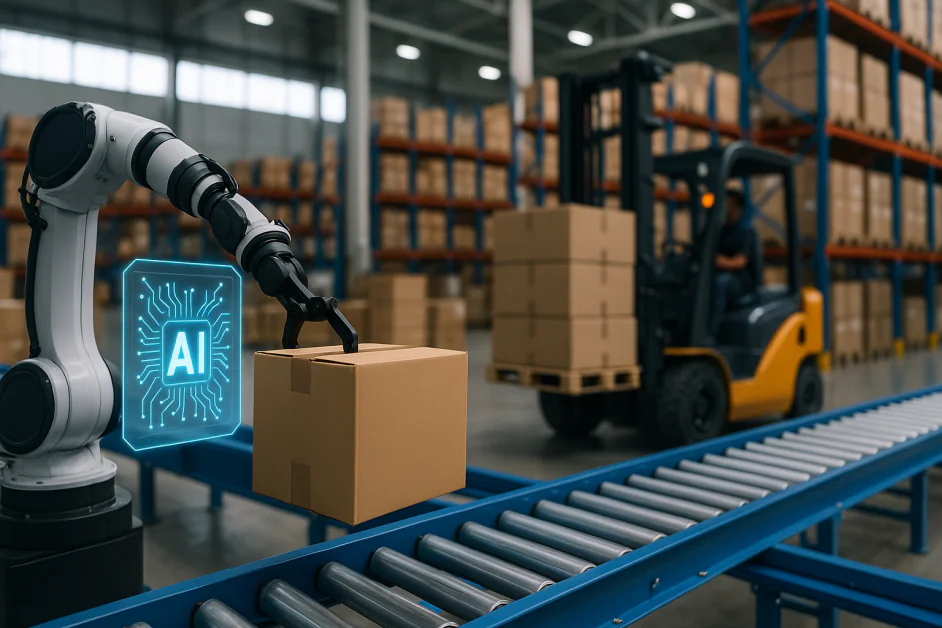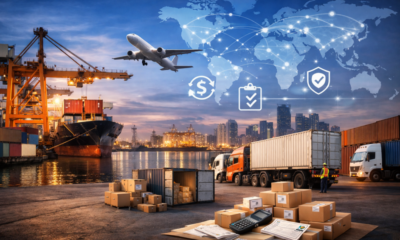Thought Leaders
Smarter, Faster, Stronger: How AI Is Reshaping the Modern Supply Chain

The modern supply chain is at a breaking point.
Volatility has become the norm, and across every region and industry, supply chain leaders are grappling with a convergence of forces that traditional methods can no longer handle. What once felt like isolated disruptions, geopolitical unrest, climate-related events, or shifts in consumer demand, have now become continuous, compounding pressures.
At this inflection point, three universal factors are bearing down on supply chain operations: unrelenting macro headwinds, intensifying margin pressures, and the urgent need to adopt AI. Any one of these would be challenging. Together, they represent a perfect storm, one that requires more than incremental change, but a fundamentally new approach to managing supply chains.
The perfect storm: three forces reshaping supply chains
Macro headwinds: volatility is the new normal
Geopolitical conflict and climate events now define global supply chains. The recent tensions near the Strait of Hormuz, where nearly 20% of global oil moves, have driven up fuel costs and insurance rates, forcing some carriers to consider costly reroutes around Africa. Meanwhile, political maneuvering, typhoons, droughts, and labor actions are compounding delays and disrupting inventory planning. Just last year, we saw 29 port strike days, and tariff whiplash is forcing companies to cancel and replace entire vessel plans.
The consequences ripple globally. One estimate suggests that disruptions through the Suez Canal alone added 0.7 points to global core goods inflation. Meanwhile, port strikes, trade policy shifts, and production relocations are accelerating the complexity that supply chain professionals must manage.
The margin squeeze: expectations up, resources down
Companies are being asked to do more with less. That means cutting transportation costs, reducing working capital, and enhancing customer service, all while hitting sustainability targets. It’s not just hard; it’s often contradictory. Yet most Global 2000 companies expect a 10% cut in transportation costs this year. At the same time, a massive $9.7 trillion in working capital is trapped in safety-stock inventory worldwide every year.
This isn’t just a technical challenge; it’s a human one. Transportation analysts are spending even more time manually juggling data. Meanwhile, customer experience teams grapple with rising expectations and a zero-tolerance approach for service failures. The pressure to improve performance while slashing costs is putting an unsustainable strain on supply chain organizations.
The AI mandate: urgency without clarity
AI has become a necessity. Executives know they need it: the majority of CEOs say their survival depends on it. But successful implementation remains elusive. Studies show that 42% of companies are abandoning AI projects mid-stream, and more than 80% of AI initiatives never make it past the pilot stage.
The noise around AI makes it difficult to know what’s real and what’s hype. Many AI initiatives fail not because the technology isn’t capable, but because they lack a clear direction or don’t integrate well with the systems already in place. As a result, companies are struggling to derive real business value despite massive investment.
The path forward: From data overload to actionable intelligence
As supply chains grow more complex and interconnected, decision-making is increasingly bogged down by too much data and too little clarity, making the ability to make fast, confident decisions even more crucial.
Many organizations have invested in visibility platforms and analytics tools, yet still struggle to make timely, informed decisions. To navigate today’s challenges, AI must be applied to enable smarter, faster action.
To help supply chain leaders navigate these challenges, here are four ways AI is already providing tangible benefits across industries—and how to approach adoption thoughtfully:
- Predictive disruption management
AI can help organizations shift from reactive firefighting to proactive risk management. By analyzing historical data, live feeds, and external signals, like weather patterns, geopolitical events, and port congestion, AI models can identify emerging risks earlier. This enables supply chain teams to evaluate alternative routes or adjust inventory levels before problems escalate. For example, during the Baltimore Bridge collapse, a major automotive company achieved $16M in cost avoidance by leveraging AI to navigate the disruption. - Automated exception handling and response
AI can assist in identifying anomalies in shipment data or supplier performance and suggest corrective actions in real time. In one instance, a Canadian automotive parts manufacturer achieved a 100% increase in productivity without acquiring headcount. This is particularly useful for managing the growing number of exceptions, like late deliveries or inventory mismatches, because it means you don’t have to track every issue manually. Automating routine responses enables teams to focus on high-priority issues and long-term improvements. - Smarter demand and inventory planning
Using a variety of data sources, from market signals to POS trends, AI can improve how accurately companies predict demand and manage safety stock. This supports better alignment between supply and demand, reducing both stockouts and excess inventory. For example, a leading Swiss medical device and eyecare company reduced inventory by one day and realized $15M in annual savings. AI can even highlight where rebalancing inventory across regions might improve service levels or reduce transportation costs. - Reducing friction through automation and augmentation
AI enables better collaboration by providing shared, real-time insights that align teams across logistics, procurement, finance, and customer service. With a unified view of operations, organizations can coordinate responses more effectively and make faster, joint decisions. When fully integrated, AI acts as a co-pilot—reducing supply chain and logistics costs by up to 15% through optimization while freeing teams to focus on strategic, cross-functional work. For instance, a US global home improvement retailer used AI to increase their response time to exceptions by 72%, showing just how effective AI can be for coordinating efforts.
Putting AI into practice: A roadmap to smarter supply chains
The future of supply chain management lies in combining human judgment with machine-driven insights. AI won’t replace the experience and intuition of supply chain professionals, but it can amplify their impact. By surfacing hidden patterns, predicting risks, and improving the speed and quality of decisions, AI allows teams to operate more proactively.
But tapping into AI’s potential takes more than just rolling out new technology. It requires strategic alignment, thoughtful implementation, and a culture that’s ready for change. For organizations looking to build more adaptive, resilient operations, here are three essential steps to make AI work:
- Start with a focused use case
Instead of attempting to overhaul your entire supply chain, start with a defined problem that AI is well-suited to solve, like improving ETA accuracy, streamlining exception handling, or optimizing inventory allocation. Early wins help build confidence, justify further investment, and create momentum. - Ensure data readiness
AI thrives on timely, structured, and integrated data. Before scaling up, ensure foundational data governance is in place. That means standardizing inputs, breaking down data silos, and improving visibility across your systems. With a strong data infrastructure, you can expect your model outputs to be more reliable and impactful. - Involve cross-functional teams
Successful AI adoption isn’t just about algorithms—it’s about people. Everyone from operations, IT, analytics, and business users should be included at the beginning. When people work together on development, it ensures that AI models are not only accurate but also interpretable, easy to use, and fit into actual workflows.
When these elements come together, AI becomes a practical, embedded part of decision-making. These decisions are not supply chain decisions; they are business decisions that impact balance sheets. The Organizations that capitalize on AI’s capabilities—acting on real-time data confidently, consistently, and at scale will be the ones who lead. With the right foundation in place, AI can help supply chains evolve from reactive to resilient, ready to meet whatever challenges lie ahead.












